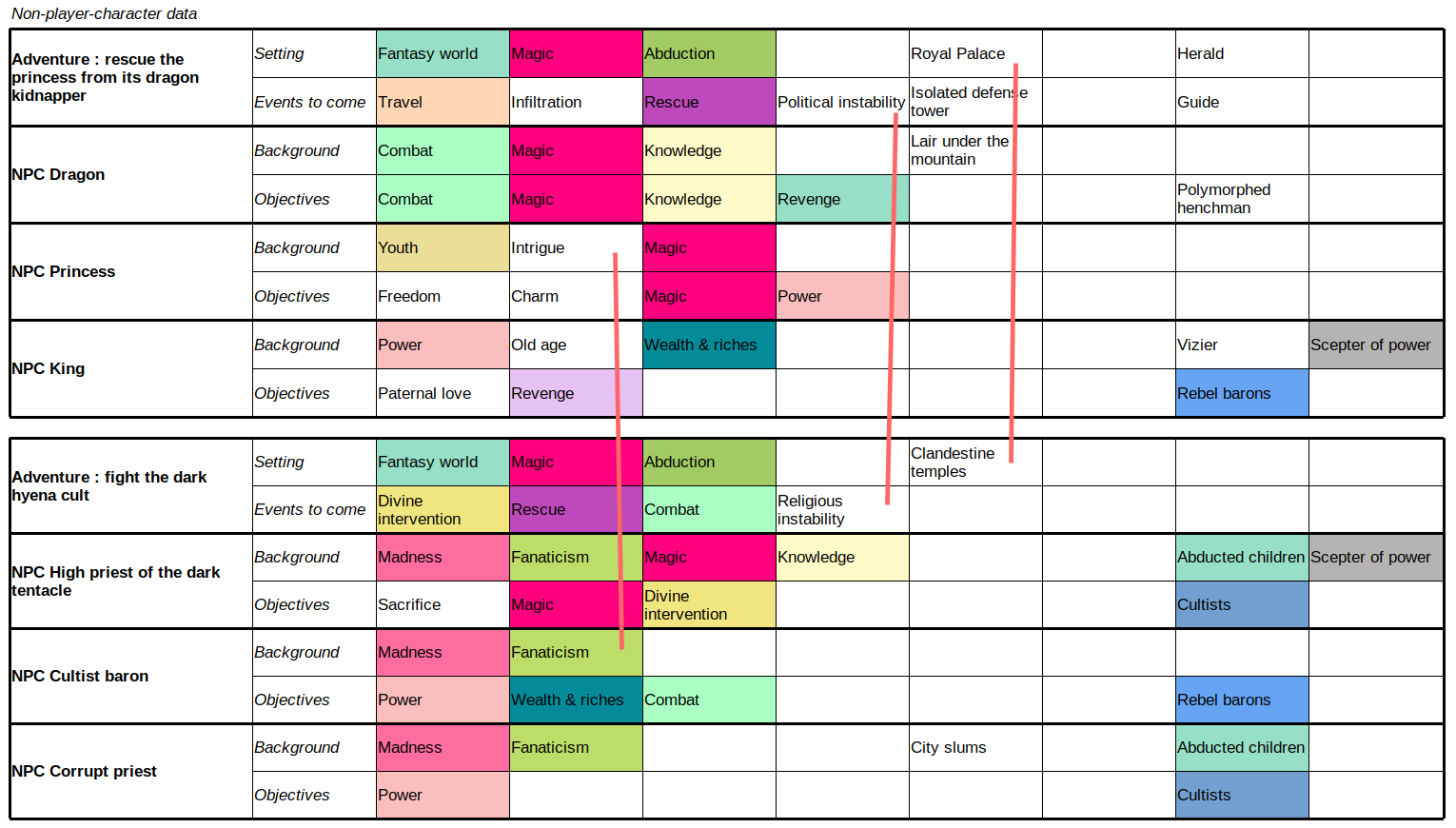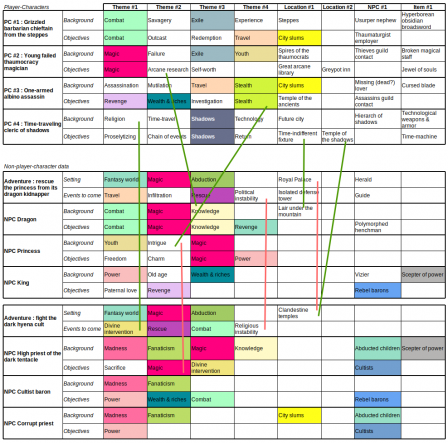Strategic Gamemastering, part 4: Matrix campaigns
Par Ludox le jeudi 14 décembre 2017, 10:57 - Lien permanent
You've read all three installments of the Strategic Gamemastering posts, and you're telling yourself that while the method certainly could work for one-shot scenarios with strongly divergent characters, you are still in doubt that the THACOSG tool could manage the several pre-written adventures, modules or 50-scenario campaign that you have bought for your favorite game.
Your main issue is that if, in accordance to the process described in Part 3 of Strategic Gamemastering, you decompose a single scenario into its base components and enter them into the THACOSG for subsequent exploitation, the player-characters will enter the scenario in a manner certainly consistent with their own objectives or background, but probably not in the manner envisioned by the scenario author but by each following their own creative agendas.
Since player-characters will be entering the narrative threads of the scenario in an uncontrollable and unpredictable manner, there is also a definite possibility that the scenario will unfold in a manner wildly different from the author-driven narrative direction. This, of course, implies a massive uncertainty as to whether the ending of the scenario will match the beginning of the next campaign scenario as envisioned by the campaign designers !
These reservations are quite legitimate. However, the Strategic Gamemastering method also provides for long-winded campaigns and even follow-up campaigns. This post will show you how.
Campaigns, in effect, are overarching narrative threads linking together a succession of scenarios which, individually, self-contain their own narrative threads. Since the Strategic Gamemastering method is precisely based on identifying and creating links between base elements, not only the scenarios but the campaign itself can be decomposed in its base components.
In perspective with the objects and concepts of its various scenarios, the Campaign + Scenario THACOSG immediately provides the GM with an overview of the themes which will be important for the overarching campaign for each scenario.
These commonalities can then be shared with the player-character team in order to deduct the salient themes which will lead the PC throughout the campaign and identify any possible difficulties - such as for example a scenario in the campaign which would require a demon-hunter PC to ally with demons...
With the campaign thus organized in the THACOSG matrix, each PC will still have the opportunity to experience the whole breadth of the campaign, by entering each campaign scenario in the PC's own manner. Furthermore, decomposition of the different campaign will also give rise to new narrative threads between the scenarios and even between successive campaigns, allowing a GM to design an overarching meta-campaign if necessary.
Let's take our (awful) kidnapped princess scenario again. Let's say that the next scenario, a completely unrelated one-shot scenario, is based on the rise in the realm of a dark cult worshipping a malevolent hyena-faced divinity, and child abduction and sacrifice. Let's organize all this information back into a THACOSG, and let us generate the various semantic links.
Of course, both scenarios are obviously magic-heavy. Other obvious commonalities, such as the hunger for power shared by the corrupt priest, cultist baron and the princess, or the fact that both scenarios involve an abduction & rescue (that of the princess in the first scenario, that of innocent children in the second) immediately arise. Rebel barons play a role in both scenarios, and both the king and the high priest of the dark tentacle have a scepter of power in their items of interest. A creative GM might want to focus on this strange commonality and decide that these scepters are the manifestations of a greater, hidden, underlying antagonist which will be revealed slowly over the course of the campaign.
Generating the THACOSG for both the unrelated scenarios has already made strong thematic and links appear between them, without any particular expenditure of mental energy from the GM. The GM only took the time to type the various keywords for the scenario, and to color cells with present identical strings.
The next step is for the GM to use his brain and think of other, not-so-obvious links between the two scenarios. Such possible GM-driven links between the two scenarios can be :
- linking political instability and religious instability seems completely natural, as the baron revolts might also feed, for example, on dissatisfaction with priestly authority abuses ;
- linking the royal palace and the clandestine temples seems appropriate, in order to provide a reason for exploring the palace, and a way for the princess to interact with the corrupt cultists. More linking to the clandestine temples would be the city slums (so that PCs who have this location as a component may follow this thread) ;
- a GM link with interesting prospects is the link between the princess intrigue thematic, and the fanaticism of the cultists : to which extent can fanatics be manipulated ? Is it possible that the princess might have made a mistake by fostering the cult in the realm ? Would she eventually call for the PCs help to remove the high priest from power or to stop the divinity to be invoked ?
Other links could be considered by the GM, but kept unconnected for the moment, and reserved for later exploitation and linking to a new scenario :
- the vizier and the high priest of the dark tentacle could be one and the same, but this would preculde the possibility of using the already established & known vizier NPC in a later campaign scenario ;
- possible connections or interactions between the dragon and the dark hyena divinity ;
- a link between the king's old age and the madness thematic of the cultists. Is it possible that the king is not the frail old man that everyone figures, and has allied to some cultists in order to placate the rebel barons and to oppose his daughter attempts to wrest power ?
Such linking will allow PCs following their own background and objectives, not only to enter the narrative threads of the first scenario, but also to seamlessly begin encountering the elements and situations which will lead to the unfolding of the next scenarios. It is also very clear that the Time-traveling cleric of the shadows will have a strong role to play in the events of the second scenario, especially with the quite natural links between religion and fanaticism, and the clandestine temple, amongst which, probably, the Temple of the shadows :
The risk would, of course, to create an opposition by considering that PC#4 is a priest of the scenario 2 cult. This would pit PC's against each other immediately. Considering the time-traveling nature of PC#4, a GM might decide that the future shadow religion is a civilized, humane offshoot of the more primitive, dark and bloody hyena god cult, which has to change in some ways, and be eradicated in others if PC#4's shadow religion is ever to exist.
This strong, natural relationship between one of the PC's and the scenario implies that the GM should invest some effort in finding other links to connect the other PCs to the first and second scenarios. For example :
- the assassin's guild contact might require PC#3 to investigate ritual assassinations unsanctioned by the guild (link between the NPC and the "Sacrifice" thematic of the High priest) ;
- the PC#2 broken magical staff might be a scepter of power comparable to that of the king or the high priest - a mystery to be investigated ;
- linking "clandestine temples" to "city slums" will also implicate PCs #1 and 3 into the narrative thread of the second scenario.
Thus organized, the scenarios allow for a comprehensive "matrix campaign" view. Regardless of their background or objectives, the PC will explore their own background and objectives, and yet gradually fulfill the narrative threads of the overarching campaign.

